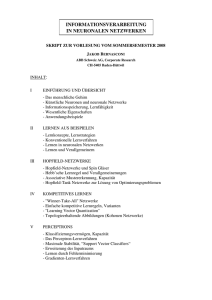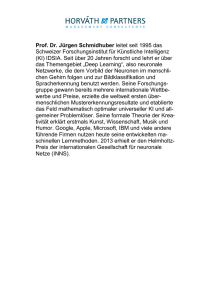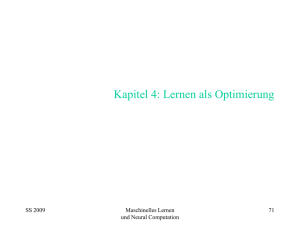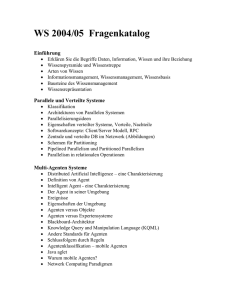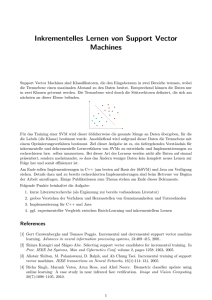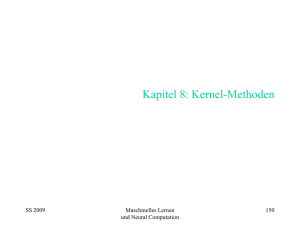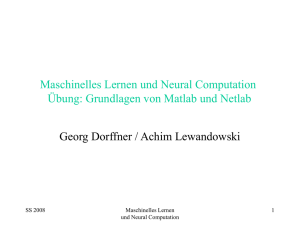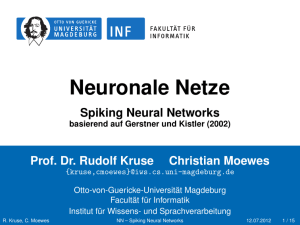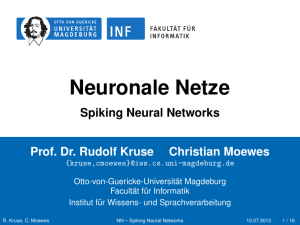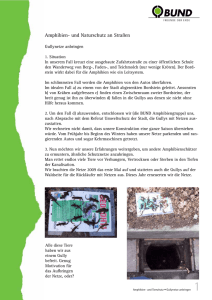Begleitende Literatur zur Vorlesung:
Werbung
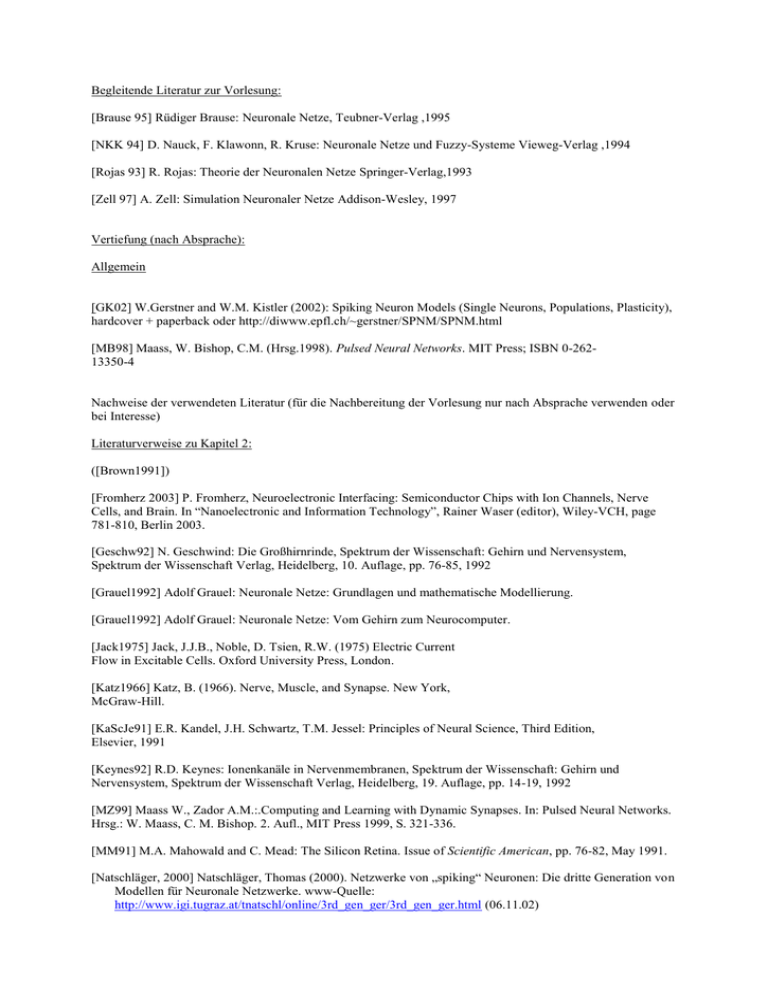
Begleitende Literatur zur Vorlesung: [Brause 95] Rüdiger Brause: Neuronale Netze, Teubner-Verlag ,1995 [NKK 94] D. Nauck, F. Klawonn, R. Kruse: Neuronale Netze und Fuzzy-Systeme Vieweg-Verlag ,1994 [Rojas 93] R. Rojas: Theorie der Neuronalen Netze Springer-Verlag,1993 [Zell 97] A. Zell: Simulation Neuronaler Netze Addison-Wesley, 1997 Vertiefung (nach Absprache): Allgemein [GK02] W.Gerstner and W.M. Kistler (2002): Spiking Neuron Models (Single Neurons, Populations, Plasticity), hardcover + paperback oder http://diwww.epfl.ch/~gerstner/SPNM/SPNM.html [MB98] Maass, W. Bishop, C.M. (Hrsg.1998). Pulsed Neural Networks. MIT Press; ISBN 0-26213350-4 Nachweise der verwendeten Literatur (für die Nachbereitung der Vorlesung nur nach Absprache verwenden oder bei Interesse) Literaturverweise zu Kapitel 2: ([Brown1991]) [Fromherz 2003] P. Fromherz, Neuroelectronic Interfacing: Semiconductor Chips with Ion Channels, Nerve Cells, and Brain. In “Nanoelectronic and Information Technology”, Rainer Waser (editor), Wiley-VCH, page 781-810, Berlin 2003. [Geschw92] N. Geschwind: Die Großhirnrinde, Spektrum der Wissenschaft: Gehirn und Nervensystem, Spektrum der Wissenschaft Verlag, Heidelberg, 10. Auflage, pp. 76-85, 1992 [Grauel1992] Adolf Grauel: Neuronale Netze: Grundlagen und mathematische Modellierung. [Grauel1992] Adolf Grauel: Neuronale Netze: Vom Gehirn zum Neurocomputer. [Jack1975] Jack, J.J.B., Noble, D. Tsien, R.W. (1975) Electric Current Flow in Excitable Cells. Oxford University Press, London. [Katz1966] Katz, B. (1966). Nerve, Muscle, and Synapse. New York, McGraw-Hill. [KaScJe91] E.R. Kandel, J.H. Schwartz, T.M. Jessel: Principles of Neural Science, Third Edition, Elsevier, 1991 [Keynes92] R.D. Keynes: Ionenkanäle in Nervenmembranen, Spektrum der Wissenschaft: Gehirn und Nervensystem, Spektrum der Wissenschaft Verlag, Heidelberg, 19. Auflage, pp. 14-19, 1992 [MZ99] Maass W., Zador A.M.:.Computing and Learning with Dynamic Synapses. In: Pulsed Neural Networks. Hrsg.: W. Maass, C. M. Bishop. 2. Aufl., MIT Press 1999, S. 321-336. [MM91] M.A. Mahowald and C. Mead: The Silicon Retina. Issue of Scientific American, pp. 76-82, May 1991. [Natschläger, 2000] Natschläger, Thomas (2000). Netzwerke von „spiking“ Neuronen: Die dritte Generation von Modellen für Neuronale Netzwerke. www-Quelle: http://www.igi.tugraz.at/tnatschl/online/3rd_gen_ger/3rd_gen_ger.html (06.11.02) [NE1996] Northmore, D.P.M. and Elias, J.G. (1996) Spike train processing by a silicon neuromorph: The role of sublinear summation in dendrites. Neural Computation 8:1245-1265. [Rall1964] Rall, W. (1964) Theoretical significance of dendritic trees for neuronal input-output relations. In Neural Theory and Modeling. Ed. R.F. Reiss, Stanford University Press, Pp 73-79. [Rehkämper1986] [Thompson1985] Richard F. Thompson: The Brain, An Introduction to Neuroscience W. H. Freeman & Co, 1985. [Thompson1990] Richard F. Thompson: Das Gehirn. [Thompson2000 ] Richard F. Thompson: The Brain: A Neuroscience Primer, 2000. [Tsodyks and Markram 1997] Tsodyks, M. and Markram, H. (1997). The neural code between neocortical pyramidal neurons depends on neurotransmitter release probability. Proc. Netl. Acad. Sci., USA, 94:719-23. Nature, 382:807-10. [Zador et al., 1998] Zador, A. M. (2001). Synaptic connectivity and computation. Nature, Neuoscience vol. 4(12), pp. 1157-1158 (www.nature.com). Literaturverweise zu Kapitel 3: [Adrian, 1926] Adrian, E. D. (1926). The impulses produced by sensory nerve endings. J. Physiol. (London), 61:49-72. [Georgopoulos et al., 1986] Georgopoulos, A. P., Schwartz, A. und Kettner, R. E. (1986). Neuronal population coding of movement direction. Science, 233:1416-1419. [KS 1991] Kandel, E. C. und Schwartz, J. H. (1991). Principles of Neural Science. Elsevier, New York, 3rd edition. Literaturverweise zu Kapitel 4: [FuMiIt83] K. Fukushima, S. Miyake, T. Ito: Neocognitron: a neural network modell for a mechanism of visual pattern recognition, IEEE Trans. On System, Man and Cybernetics SMC-13, pp. 826-834, 1983 [Fukush75] K, Fukushima: Cognitron: a self-organizing multilayered neural network, Biological Cybernetics 20: pp. 121-136, 1975 [Hopfie82] J.J. Hopfield: Neural Networks and physical systems with emergent collective computational abilities, Proc. of the National Academy of Sciences, USA, Vol. 79, pp. 2554-2558, 1982 [Hofie84] J.J. Hopfield: Neurons with graded response have collective computational properties like those of two-state neurons, Proc,. of the National Academy of Sciences, USA, Vol. 81, pp. 3088-3092, 1984 [Kohone77] T. Kohonen: Associative Memory - A System Theoretic Approach, Springer 1977 [Kohone82] T. Kohonen: Self-organized formation of topologically correct feature maps, Biological Cybernetics 43, pp. 59-69, 1982 [Kohone84] T. Kohonen: Self-Organization and Associative Memory, Springer Series in Information Sciences, Springer Verlag, 1984 [Kohone89] T. Kohonen: Self-Organization and Associative Memory, Springer Series in Information Sciences, Springer Verlag, third edition, 1989 [RuHiWi86a] D.E. Rumelhart, G.E. Hinton, R.J. Williams: Learning internal representations by error propagation, in D.E. Rumelhart, J.L. McClelland (Eds.): Parallel Distributed Processing: Explorations in the Microstructure of Cognition, Vol. 1, MIT Press, Cambridge, MA, pp. 318-362, 1986 [RuHiWi86b] D.E. Rumelhart, G.E. Hinton, R.J. Williams: Learning representations by back-propagating errors, Nature 323, pp. 533-536, 1986 [RumMcC86] D.E. Rumelhart, J.L. McClelland: Parallel Distributed Processing: Explorations in the Microstrucure of Cognition, Vol. 1: Foundations. The MIT Press, 1986 [Wasser89] P.D. Wassermann: Neural Computing, Theory and Practice, Van Nostrand Reinhold, 1989 [Widner60] R.O. Widner: Single-State logic, AIEE Fall General Meeting, 1960, in P.D. Wassermann: Neural Computing, Theory and Practice, Van Nostrand Reinhold, 1989 Literaturverweise zu Kapitel 5: [Hirsch] [RuHiWi] s.o.
